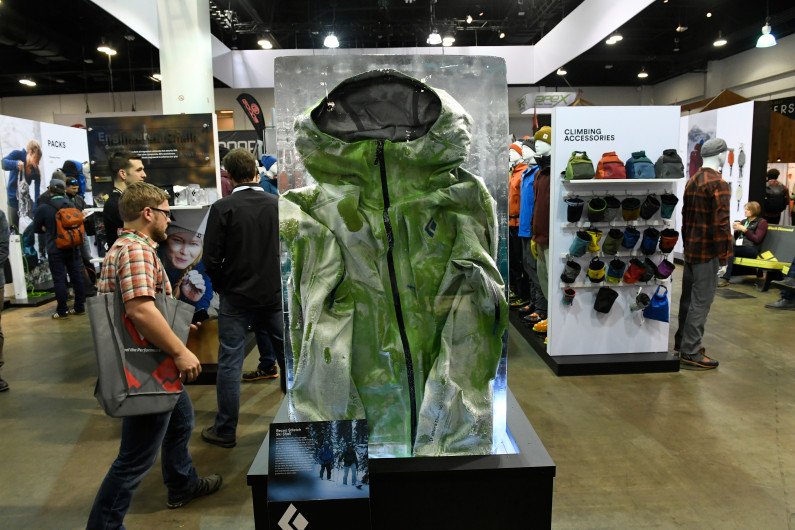The Recon Stretch Ski Shell by Black Diamond is encased inside a block of ice at the Black Diamond booth at the Colorado Convention Center during the Outdoor Retailer + Snow Show on Jan. 25, 2018 in Denver. The show is the nation’s largest outdoor sports expo and conference. Outdoor Retailer + Snow Show is the first time in nearly 30 years that the outdoor and snow industries will be together. Outdoor Retailer + Snow Show say that their show is about community and having one place where the industry can gather.
Outdoor businesses look at absorbing costs or passing them on to customers
Tariffs aren’t a conversation topic you’d expect at the Outdoor Retail show, but it’s one that’s having a significant impact on the outdoor recreation industry.
So much so that some small-business owners in the industry are worried about the future of their companies.
Items on the third list of tariffs in the escalating trade war between the U.S. and China are of concern to outdoor recreation companies, said Rich Harper, ( the Outdoor Industry Association’s manager of international trade.
“Most outdoor products escaped lists one and two,” Harper said Thursday during an association event at the Colorado Convention Center.
But the third round of tariffs on $200 billion of imports from China includes leather ski gloves, backpacks, camp stoves and chairs, bicycles and kayaks. An additional 10 percent tariff was imposed on the products Sept. 24 and that will increase to 25 percent at the end of the year, Harper said.
One success was exclusion of snowboard and bike helmets from the list.
“Tariffs are essentially taxes, so additional taxes means the costs for outdoor companies are going to go way up,” Harper said. “They’re faced with the decision right now whether to absorb that cost or pass that cost on to the consumer.”
However, many retailers have already set their prices for 2019, so they will have to absorb the increases. Harper said some outdoor recreation business have estimated that every additional $1 in tariffs converts to an additional $4 in retail costs. Higher tariffs will also likely translate into fewer jobs filled, he added.
What keeps him up at night, Harper said, is the potential for more tariffs, which the Trump administration has said could be levied if China retaliates. More than $260 billion in additional tariffs would inevitably include footwear and apparel: hiking boots, trail-running shoes, ski jackets and rain coats.
“We sell apparel on a seasonal basis, so we have offered all our samples for fall 2019,” said Saunders, country manager for Salewa North America, headquartered in Boulder.
Because the prices have been set, the company would likely absorb the cost of higher tariffs, but eventually have to pass them along to customers. Salewa is looking for vendors in other countries, but Saunders said shifting even a portion of its business could take years.
“China is such a large country, has such a significant manufacturing base for apparel and footwear, there’s just not the same volume in other countries,” Saunders said. “It’s not like there are dormant factories just waiting for work in Vietnam and other places.”
In some cases, Harper said outdoor companies trying to shift their supply chain might end up with a lower-quality product or be forced to discontinue products altogether. More than 90 percent of many outdoor products are manufactured in China, he added.
“We’ve heard from a number of members in the past few weeks that they’re concerned if there’s no relief in sight that ultimately they’ll have to go out of business, particularly those that are small or medium-sized,” Harper added.
Industry representatives are talking to members of Congress and federal officials to make their case against more tariffs or exempting outdoor products from the list of targeted imports. Harper said he understands the tariffs are intended as a way to get China to stop the theft of American intellectual property, but that issue doesn’t apply to outdoor recreation products.
“It’s very challenging,” Saunders said of the fallout from the trade dispute. “It’s a major distraction and a lot of uncertainty.”
Source: The Denver Post, November 2018

